I’m never sure as to what each week will bring here in Coos Bay. Every week has always managed to top the previous and this week was no exception. Tuesday, Scott, Jim, and I boated down to Indian Point to start the ODFW’s annual cockle survey. Using ArcGIS I generated 60 random points and uploaded the locations of these 60 points onto a GPS. These 60 points would serve as our sampling sites. We would lay down one square meter quadrats at the waypoints found on the GPS and rake a four tine rake over the quadrat once and record and collect the cockles found. Then we would turn 90 degrees and rake one more time and record the number of cockles found and collect them as well. This was repeated for each quadrat.
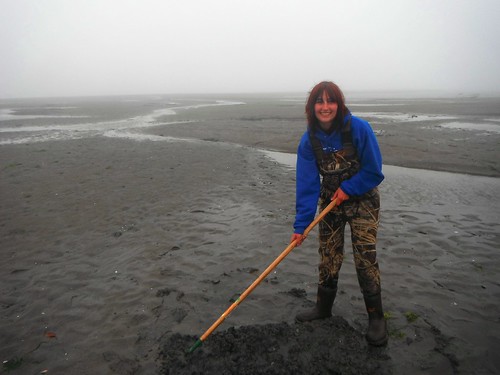
Raking for Pacific Heart Cockles at Indian Point
On Thursday we did this same process, only this time at Valino Island. Valino Island is a protected area and Indian Point is an area known for heavy commercial harvest of cockles. We chose these two sites in order to compare how harvest (or lack thereof) affects cockle size and recruitment over time. While Indian Point was very sandy Valino Island was quite the opposite. Valino Island is essentially a mud flat and it is easy to get stuck and sink. Scott and Jim had to pull me out of the mud several times, but not before musing—i.e., laughing—over how funny they thought my predicament was.
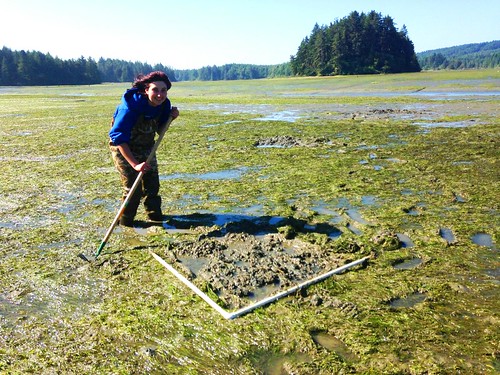
Stuck in the mud at Valino Island
When we returned back to the ODFW I placed the cockles into tanks of circulating water in order to take accurate wet weights. When clams are left out of water they tend to spit water out of their siphons which can give you inaccurate weight data; this is why we placed the clams back into water before recording weight. I also recorded shell length, height, and fatness which will be used in our analysis. Using R we ran some preliminary statistical tests that suggest that Valino Island, the reserve area, has much larger cockles but Indian Point has higher amounts of recruitment.
We also have been continuing our red rock crab surveys and we were lucky enough to have the pleasure of working alongside Sylvia Yamada, a professor and research scientist from OSU. Sylvia has been doing work throughout the years on the invasive green crab and was a delight to work with. Her plethora of knowledge and fascinating anecdotes made for a great week of crab processing. She brought Fukui traps, a Japanese trap that allows all sizes of crabs to walk through. We had been using box traps which bias samples by not letting the larger crabs in. However we did run into some trouble with the Fukui traps: the seals ate all our bait!
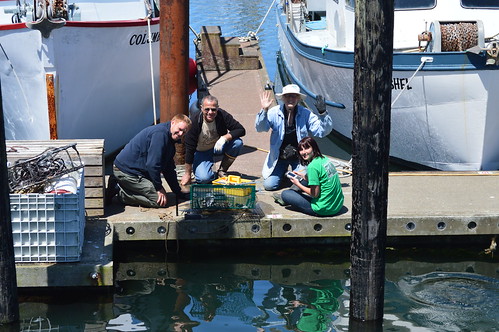
Scott, Larry, Sylvia, and I processing red rock crabs

The notorious bait thief!
Thursday was considerably out of the ordinary. Dean, a fish biologist for the ODFW, invited me along to process yellow-eyed rockfish with him. It was truly a treat as yellow-eyed rockfish have a harvest limit of two tons per year—a very small allowance—and are not often encountered. We recorded lengths and weights of the rockfish and also recorded their sex and stage of maturity. Dean also pulled otoliths from the rockfish. Otoliths are ear bones and are used to determine the age of a fish. We even had encountered a few fish that had been eaten by hagfish, which enter through the gills and eat the fish from the inside out. The fish remains whole but the body is completely flaccid as all its musculature and organs have been consumed. It was very surreal to see. And on top of the fun of handling some cool fish, a buyer stopped by to purchase halibut from the boat we were working with and gave us all brownies. Brownies for breakfast: how could I say no to that?
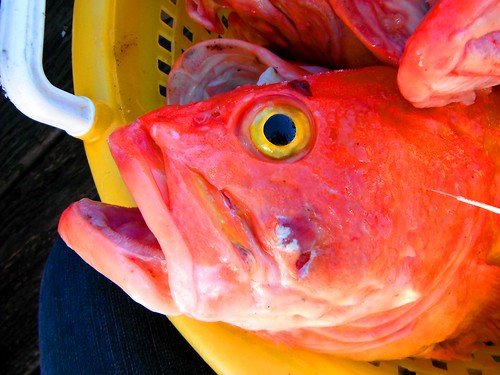
Yellow-eyed rockfish
Later in the week, Jim Carlton, an expert on the subject of Japanese tsunami marine debris (JTMD) and invasive species, came to visit OIMB to give a lecture on the incoming debris and teach a class on the topic of biological invasions. In a previous blog post I mentioned how Scott and I had discovered a Japanese pallet that had washed ashore. We had sent the samples and pictures we had taken to Jim and during his visit he informed us that the pallet had come from the Morinaga-dairy business, a famous dairy business in Yamato which is located in the metropolis of Tokyo. It was determined that the pallet contained various hydroids, Mediterranean mussels (M. galloprovincialis), pelagic barnacles known as Lepas, as well as jingle shells (Anomia cytaeum). Jingles are not commonly found on JTMD which made it an interesting find.
There is no such thing as a dull weekend at OIMB. Friday night the director, Jan, announced that a dying dolphin had washed up on Bullard’s Beach in Bandon and was hoping to have help in retrieving it. And so, Saturday morning I had the opportunity to drive to Bandon with a group of friends to help Jan retrieve the dolphin so that it could be dissected in the Birds and Mammals course. After about fifteen minutes of combing Bullard’s Beach we found the dolphin, loaded it onto a stretcher and carried it up and over the dunes to the truck to be hauled back to OIMB. The dolphin weighed over 200 lbs. but with one person on each corner of the stretcher it wasn’t as difficult as I thought it would be to carry. Though, I’d be lying if I said I didn’t feel a little sore!
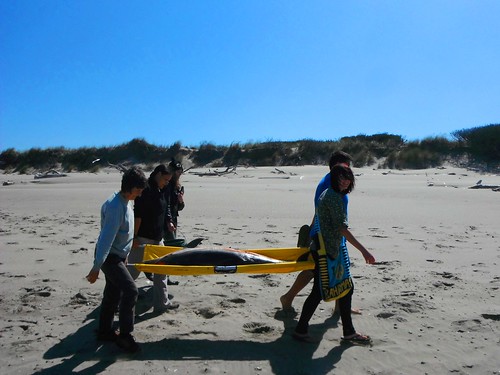
Recovering a striped dolphin for dissection

As you can see, the birds had gotten to the specimen before we did
This coming week I’ll be heading to Corvallis to talk to the public about my summer work and Oregon Sea Grant. Each week always unfolds a new and exciting surprise and I’m ready to see what that will be this week! Until next time!

















